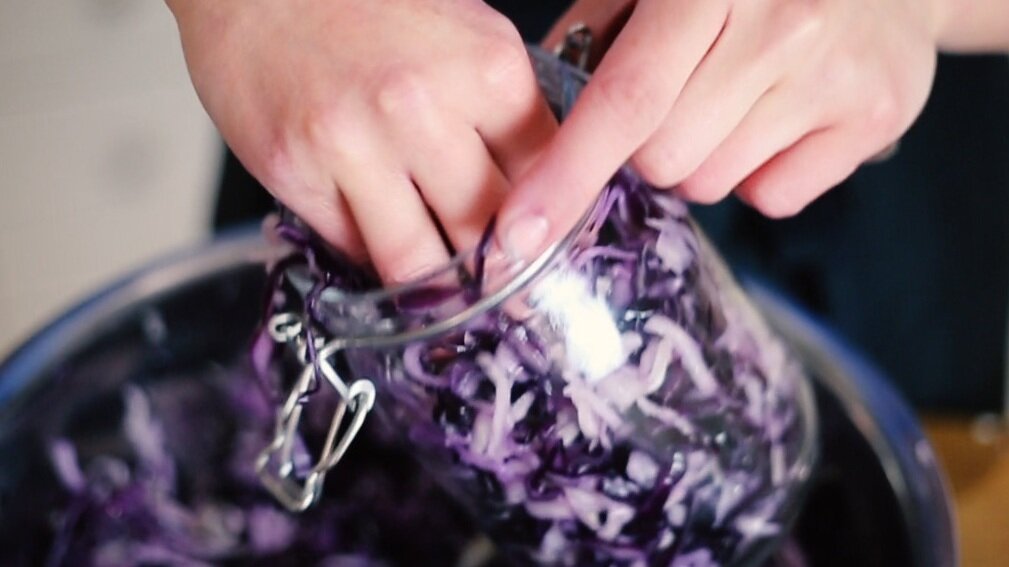Classic sauerkraut (& Christmas kraut)
For many of us, Sauerkraut is the gateway drug... the ferment we learn and love first. It's the blank canvas on which we master the manipulation of salt, time & temperature, grow in confidence, and start to experiment with flavour. It was the first ferment Joey learnt how to make many years ago, and the first fermented vegetable she introduced a very skeptical Katy too when they first started cooking together. In no time Katy was hooked on that complex, savoury tang...
Sauerkraut is the most classic example of the 'dry-salt' method of fermentation. For the dry salt method we use a ratio of 2% salt, which is far more straightforward than it sounds… read on, we’ve filmed a YouTube video here, and broken things down into an easy step-by-step process below.
This recipe fills a 1 litre flip-top Kilner jar.
Ingredients:
1 large cabbage (either red or white, but red for Christmas kraut)
20 g flakey sea salt
1/2 tsp ground allspice (for Christmas kraut only)
2 star anise (for Christmas kraut only)
1 red chilli, very finely chopped (for Christmas kraut only)
Method:
Wash your hands, cabbage, chopping board and knife well - it’s important that no harmful bacteria get involved at the beginning. Next, sterilise your jar by giving it a good wash and rinse, then standing it in a preheated oven (140 degrees), for 10 minutes. Remove the rubber seal before placing the jar in the oven. Pour boiling water over the rubber seal to sterilise.
Cut off the base of the cabbage and keep this to one side, it will be helpful later. Discard the 2 external leaves, then quarter the cabbage, cut away the hard central core (hold onto these offcuts too) and finely shred.
Weigh your shredded cabbage into your largest mixing bowl. You’ll only need 1 kg of shredded cabbage here, so if you have any excess, remove this from your bowl and save for an alternative recipe.
Sauerkraut uses a ratio of 2% salt : for 1kg of shredded cabbage 20g of sea salt is needed. Sprinkle the salt over the cabbage and begin to scrunch! Slow, strong and steady works best. As the cabbage bruises it will soften and release approximately 1 cup of water. This will take about 10 minutes.
Once the cabbage is soft and there’s lots of free liquid in the bowl, pack your sterilised jar and compress down each handful as you go. Removing all the air pockets creates an anaerobic environment where the healthy lactic acid bacteria can thrive.
Pour over the excess cabbage juice from the mixing bowl to fill your jar. Wipe away any exposed bits of cabbage which poke above the water line and make sure the neck of your jar looks clean.
Trim around the cabbage base you popped to one side earlier until it fits neatly in the neck of the jar. This will act as a ‘bung’. If you need a little extra height to fully compress the cabbage use an offcut of the central core. The shredded cabbage should be encouraged to remain below the water line as the lid is closed.
And now to ferment! Stand your kilner jar in a bowl and leave it at room temperature for 3-4 weeks. Keep it away from central heating and out of direct sunlight, and, most crucially, ‘burp’ your jar each day to allow the carbon dioxide to escape. CO2 is a natural byproduct of fermentation but if too much pressure builds up inside the jar it can become dangerous.
After 3 weeks - or slightly longer if you love a seriously tangy kraut - your cabbage will be pleasantly acidic, and bursting with gut-healthy bacteria. Once fermented it will last in the fridge for up to 6 months, just remember to use a clean spoon each time.
Think of it as tangy, ultra healthy coleslaw and use it in the same manner… with oozy cheese toasties, in burgers and hot dogs, and on top of jacket potatoes with hummus or on top of a creamy bowl of dhal.


